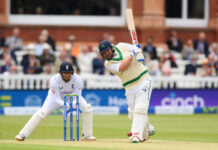On the face of it, the fact that well-established cricket commentators should apparently be shocked by the qualifying system for the 2023 World Cup is one of the more surprising features of the mini-storm which erupted around their not-entirely-impromptu discussion as they waited for the Test to start on Monday.
After all, the establishment of the 13-team Super League which is a key element of the qualification pathway was announced as long ago as October 2017, and the entire pathway with its ‘complicated’ structure a year later.
Indeed, but for the intervention of the Covid-19 pandemic six three-ODI series, involving nine of the thirteen countries, would have been played by now.
None of those would have involved England, it is true, so perhaps they might not have reached even the peripheral vision of English commentators, although it is perhaps also the case that the ICC drew the Super League to their attention with their bizarre announcement on Monday of the ‘launch’ of the competition with the England-Ireland series at Southampton on Thursday, which made only the barest of mentions of those postponed series.
That, too, would be surprising, were it possible for us to be surprised any more by the emanations from the ICC Media Department.
What is absolutely not surprising is what Andrew Strauss, in his explanation of the background to the qualification pathway, did not, and perhaps could not, say: that the root of the problem is the determination of the ICC to persist with a 10-team World Cup, and with its consequent need to pretend that anyone other than Full Members has a realistic chance of playing in it.
To understand this we have to revisit the history, with apologies to those who have this whole sorry story by heart.
Back in the heady days of the ICC Global Development Program, cricket’s bosses appeared to be set on a course of steady expansion of the 50-over World Cup, increasing the number of teams from twelve in 1999 to 14 in 2003 and to 16 (the ten Full Members plus six Associate qualifiers) in 2007.
But then things started to go wrong: despite the many handicaps they faced, and thanks in no small part to the ICC’s own High Performance Program, Associates were beating Full Members, culminating in the premature bundling out of India and Pakistan after the group phase of the 2007 event.
On the pretext that that tournament had been too long, the ICC Board decided in March 2008 that the next World Cup would be reduced to 14 participants, promising that the result would be a competition played over ‘a substantially shorter period.’
The result was a 2011 World Cup which lasted just four days fewer than its predecessor, and involved only two matches fewer (see Table 1).
Table 1: World Cup structure, 1999-2019
| Year | No. of teams | Dates | No.of days | No. of matches | Format |
| 1999 | 12 | 14 May – 20 June | 38 | 42 | 2 groups (5x) + Super 6 (2x) + SF + F |
| 2003 | 14 | 9 February – 23 March | 43 | 54 | 2 groups (6x) + Super 6 (3x) + SF + F |
| 2007 | 16 | 13 March – 28 April | 47 | 51 | 4 groups (3x) + Super 8 (6x) + SF + F |
| 2011 | 14 | 19 February – 2 April | 43 | 49 | 2 groups (6x) + QF + SF + F |
| 2015 | 14 | 14 February – 29 March | 44 | 49 | 2 groups (6x) + QF + SF + F |
| 2019 | 10 | 30 May – 14 July | 46 | 48 | Round robin (9x) + SF + F |
That did not go far enough for the most powerful ICC members, however, or for their media partners, and in April 2011 the Board decided that the 2015 event would not only be reduced to ten teams, but that those ten would be the Full Members, thus abolishing qualification completely.
This was a step too far even for many commentators in Full Member countries: while supporting the idea of a 10-team World Cup, for example, Malcolm Conn writing then for News Limited described the decision as carrying ‘the unmistakable stench of rampant cronyism.’
After a considerable international furore the Board was forced to concede that the 2015 World Cup would, after all, have 14 participants, although at the same time it confirmed that the next one, in 2019, would indeed have ten teams (though with some qualification), and punished the unruly Associates by reducing the next two T20 World Cups from 16 teams to 12.
The real reason for all this, of course, had nothing to do with the length of the tournament, which despite the ICC’s claims to the contrary, remains of about the same length regardless of the number of participants. Nor is it about the shibboleth of ‘competitiveness’, although that is a subject for another article.
What it’s all about is ensuring that the ‘Big Three’ of India, Australia and England, regardless of their performances on the field, should get to play as many matches as possible (see Table 2).
Table 2: World Cup experience of the ‘Big Three’
| Year | Australia | England | India |
| Minimum Games / Actual games played | Min. / Actual | Min. / Actual | |
| 1999 | 5 / 10 | 5 / 5 | 5 / 8 |
| 2003 | 6 / 11 | 6 / 6 | 6 / 11 |
| 2007 | 3 / 11 | 3 / 9 | 3 / 3 |
| 2011 | 6 / 7 | 6 / 7 | 6 / 9 |
| 2015 | 6 / 9 | 6 / 6 | 6 / 8 |
| 2019 | 9 / 10 | 9 / 11 | 9 /10 |
Hence the need for a round robin first phase, and to protect the interests of the Full Members by creating a qualification gateway which is as narrow and restrictive as possible.
This has been complicated by the elevation of Afghanistan and Ireland to Full Member status, since this means that even an all-Full Member World Cup will necessarily exclude two Full Members, and more if, perish the thought! one of the pesky Associates manages to squeeze through.
So in Zimbabwe in 2018 four Full Members and six Associates contested two places in the 2019 World Cup, and the next Qualifier will offer the same challenge, with any Associate needing to displace three Full Members to make it.
It may be complicated, but it’s a necessary complication to give the illusion that emerging cricket nations are being given a fair go by the self-interested gang who run the world game.
Keep up with news and events happening in the emerging game through our Facebook and Twitter pages, as well as our calendar of events!
Looking for audio content on the emerging game? Add the Emerging Cricket Podcast to your favourites on Apple, Spotify and Podbean.
Want extra Emerging Cricket content? Contribute to the Emerging Cricket Patreon cause from as little as $2 a month. Sign up here!







